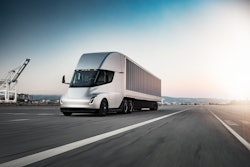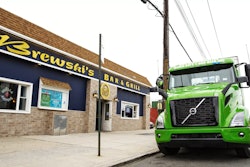Volvo Trucks North America takes its carbon footprint very seriously, which is why they have committed to shrinking it.
The company's New River Valley (NRV) manufacturing plant already is a carbon neutral facility, is fully powered by local renewable electricity and is landfill free. But VTNA President Peter Voorhoeve said it's not enough that the facility itself be green. It's important that those who service the manufacturing site join the truckmaker on its quest to clean up the environment.
Watsontown Trucking Company and Camrett Logistics, two VTNA customers and carrier partners, placed orders for their first Volvo VNR Electric trucks – the first deployments of Volvo's battery-electric model in Virginia. By the end of this year the Virginia-based fleets will deploy the zero tailpipe emission trucks to transport inbound parts and components daily to NRV in Dublin, Virginia.
It's increasingly common for shipper customers to lean on carriers to go green, seeing trucking company's tailpipe emissions as part of their own. However, Voorhoeve noted neither carrier were forced to adopt electric, rather they opted into a partnership VTNA announced in August that would cut emissions of trucks coming into the plant.
"That's the ultimate level of partnership," Voorhoeve said, adding the initiative with Watsontown Trucking Company and Camrett Logistics was an opportunity to continue its partnership with fleets already servicing local NRV logistics routes, "and to utilize Volvo VNR Electrics to reduce the carbon footprint of our own supply chain."
The trucks will complete up to 12 roundtrips per day from their local warehouse facilities to NRV. The Volvo VNR Electric’s 264-kWh lithium-ion batteries have an operating range of up to 150 miles. Regenerative braking can increase range by returning up to 15% of the power back to the battery, depending on the duty cycle. Voorhoeve said Volvo is helping support the trucks with charging facilities at the plant, but the carriers will rely mostly on charging terminals at their respective depots along with mobile options.
Deploying the electric models is expected to reduce carbon emissions by approximately 140 metric tons annually (46.53 metric tons per truck each year) and reduce diesel use by around 18,000 gallons per year.










